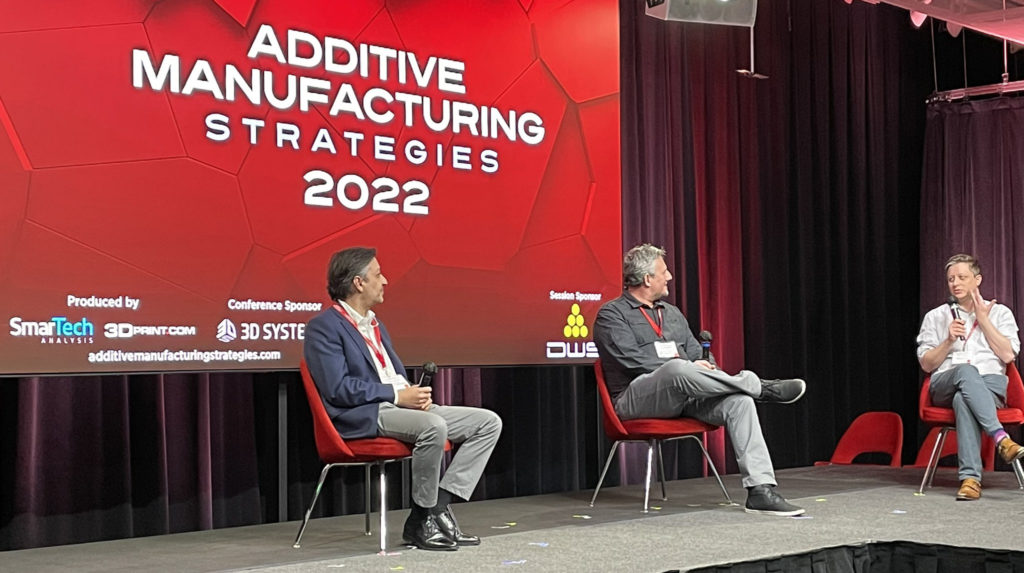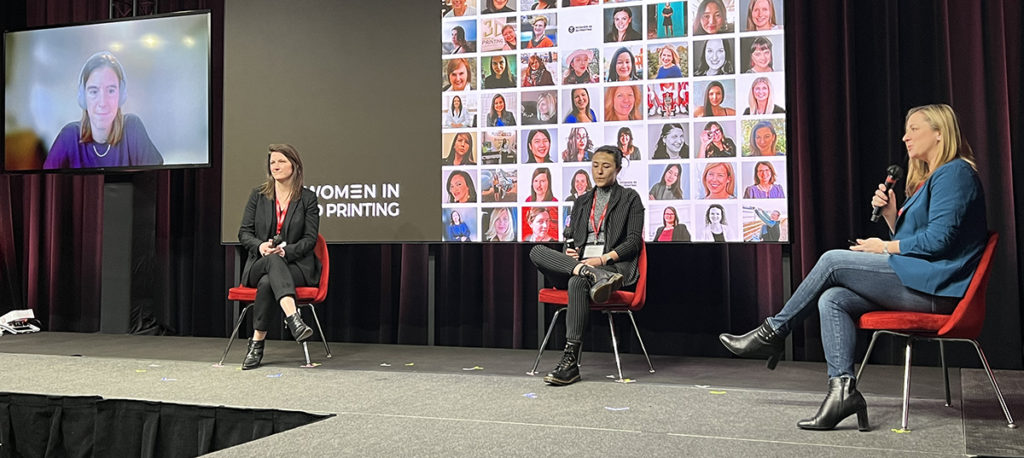Additive Manufacturing Strategies (AMS) swept into New York and, on March 2, 2022, the day was dedicated to healthcare and bioprinting. The topic was one near and dear to many attendees’ hearts, literally and figuratively, given the direct benefits 3D printing could bring to the sick and the well.
Before discussion of the topic began, 3DPrint.com Executive Editor Joris Peels started with a thought experiment to ease companies into the possible uses of 3D printing: can you 3D print a golf club? The clever and entertaining talk could apply to any vertical, intended to relax company team members before they actually consider how additive manufacturing (AM) can be used in their business. As an exercise in lateral thinking, it also eased attendees into the next panel.

Medical 3D Printing
Oliver Smith, Founder and Principal Consultant for Rethink Additive, moderated a discussion on “3D-printing in implants and orthopedics” with Benjamin Johnson, Vice President of Portfolio & Regulatory at 3D Systems; Phil Reeves, Managing Director at Reeves Insight Ltd.; and Jeff Herman, Co-Founder and CEO of Fabric8Labs. The most exciting aspect of this conversation had to be the novel technologies emerging from these companies.

A peek into the production suite at AMS 2022, managed by a great stage crew.
In particular, Fabric8Labs has developed an electroplating-style process for creating small metal parts. As Smith pointed out, the potential for the technology in healthcare is immense as it could be possible to produce large quantities of catheters or laparoscopic tools simply by extending the X- and Y-axes of the vat.

Image courtesy of Fabric8Labs.
This was followed by a panel on “3D printing in surgical planning and modeling” hosted by this author and featuring Robert Wesley, Biomedical Engineering Manager of Additive Manufacturing at Ricoh USA, and Gaurav Manchanda, Director of Medical Market Development at Formlabs. Manchanda has had a wild career ranging from serving as an advisor to the Ministry of Health in Liberia to working with the Powering Health initiative of the US government.
He shared an interesting insight that many of the customers he works with are actually surgeons who use desktop machines to explore the possibilities of 3D printing anatomical models and surgical guides themselves. This then leads to others in a hospital seeing the technology and adopting it, ultimately leading management to consider investing in 3D printing on a larger scale.
In the case of Ricoh, the Japanese imaging and electronics firm has established a service bureau. This makes it possible for surgeons and physicians to use 3D printing without investing in the technology directly. Using IBM software, CT scans can be easily converted into segments that they can order from Ricoh, who then uses Stratasys PolyJet to 3D print multicolor, multi-material models. These can then be used for diagnosis, education, or surgical planning.

Ricoh 3D for Healthcare partners with Stratasys to create anatomic models. Image courtesy of Ricoh.
During the morning healthcare segment, other topics included “End user hospitals and clinical experiences” and Regulation of “Additive Medical.” Such experts as Shannon Walters, Executive Manager of 3DQ Lab at the Stanford University School of Medicine; Albert Woo, Associate Professor of Surgery, Pediatrics and Neurosurgery at Warren Alpert Medical School of Brown University; and Amy Alexander, Unit Head of Biomechanical Development and Applied Computational Engineering at Mayo Clinic; reflected on what it’s like to really use 3D printing in a hospital environment.
There, it’s difficult to find space to justify the establishment of an AM lab, despite the immense benefits 3D printing anatomical models and surgical guides can bring, as Alexander explained. Even then, establishing a rapport between the lab and surgeons can be difficult, as doctors are already extremely busy. Getting them to sit down and plan a surgical model or guide three weeks out can be difficult, and if the 3D printed object doesn’t turn out properly, the lab might take the blame, according to Woo.
Dental 3D Printing

Dental practitioners can face some of the same challenges as those in the medical field, particularly in terms of how dentists and orthodontists learn to use the technology. As I learned on another panel I moderated, “Improving the patient experience with 3D printing,” Kunal Lal, Partner at Elk Dental Associates, first turned to 3D printing in 1999 to produce a surgical guide. To do so, he relied on Materialise AM services. Now, however, he uses a NexDent system from 3D Systems in his office to 3D print parts. Amazingly, Lal is actually following up on that same patient he treated over two decades ago.
In fact, chairside 3D printing is becoming increasingly common—so common that DWS, the Italian firm that released the first commercial desktop stereolithography 3D printer in 1991, has developed a suite of 3D printers specifically for that application. Maurizio Costabeber, CTO of DWS, discussed the product range in his keynote. The DFAB series, which was on display in the exhibit hall, is the closest thing to an espresso machine a 3D printer could be. With various materials available, a dentist or orthodontist can simply pop in a cartridge, convert an intraoral scan into a model, and click print. The machine is designed to handle the viscous materials necessary for increasingly permanent restorations and other products, and it can print them in just 10 to 30 minutes.
Meanwhile, as practitioners begin using more chairside solutions, dental labs are also adopting the technology at higher rates. A leader in this segment is Glidewell, which has some 400 3D printers in its facilities, according to Ankush Venkatesh, Intrapreneur of Additive Manufacturing at Glidewell. When a dentist can’t produce their own items or prefers not to do so, Glidewell has perfected its own workflow for mass-producing custom items that can be shipped back to their dental customers quickly. Daniel Alter, Principal of Dental Technology Consulting, explained that regardless of whether it’s done through a lab or chairside, the benefits apply to both the patient and the practitioner. A patient can sometimes have their treatment by the end of a visit, thus reducing the number of visits for a surgical procedure. In turn, the dental surgeon then has more time to see other patients.
Bioprinting
For anyone dreaming of the future, the bioprinting portion of the day was irresistible. It kicked off with a keynote from Itedale Namro Redwan, Chief Scientific Officer at CELLINK, who essentially broke down the company’s various bioprinting efforts. The company had a booth in the exhibit hall where its lab-oriented BIO X 3D printer was displayed alongside the BIO CELLX, a new platform for high-throughput hydrogel extrusion. Essentially, it’s a mini mass production machine.
This was followed by a panel led by our own Vanesa Listek on “Current uses of bioprinting,” in which Taci Pereira, Vice President and General Manager of Bioprinting for 3D Systems; Andrew Lee, Head of Bioprinting and Co-Founder of FluidForm; and Yu Shrike Zhang, Assistant Professor at Harvard Medical School. It’s honestly mind-blowing what 3D Systems is doing in bioprinting, with their work with United Therapeutics about as close to a complete 3D printed organ as you can get. However, Pereira’s work with Allevi is seeing researchers using the technology now to create labs on chips.
In a Joris-led panel on “Trends in the bioprinter market,” we heard from Kenneth Church, Founder of Sciperio Inc.; Stephen G. Gray, Founder of 4D Bioprinting; and Martin Hermatschweiler, Co-Founder and CEO of Nanoscribe. Nanoscribe, now a subsidiary of BICO/CELLINK, is 3D printing materials at the nanometer level, while Sciperio’s nScrypt has created a Factory in a Tool, which means not just bioprinting on the International Space Station but producing electronics and other functional components.
In addition to a panel on “Markets for printable biomaterials” and a talk on “Future applications of bioprinting,” the day closed out with a panel hosted by Women in 3D Printing (Wi3DP). Wi3DP President Kristin Mulherin, also general manager of Powder Bed Solutions at Nexa3D, moderated a discussion on “Point of Care 3D Printing”. Here we learned about the realities of the technology, including the role of regulation in the adoption of the technology. For instance, Magdalene Fogarasi, AM Engineer at the FDA, explained how the pandemic led to the quicker roll out of many 3D printed medical products, which has since slowed down a bit now that there’s less need for immediate products like face masks and respirators.

This was all topped off with a happy hour hosted by Wi3DP at The Brazen Tavern. While AMS held a happy hour at the event site the night before, this felt like a much more casual location to cultivate a greater sense of comradery. Plus, people who hadn’t attended AMS were present, adding some much-needed occupational diversity. The success of the night could be measured in decibels, and room capacity, with partygoers packed elbow-to-elbow, and discussing topics that far exceeded the boundaries of AM.
While we may have begun the day with the serious topic of healthcare, we ended things with a jovial atmosphere of lagers, wines, and cocktails. I’m urging the event planners to add more of this, possibly with a greater presence of groups like Wi3DP.
Subscribe to Our Email Newsletter
Stay up-to-date on all the latest news from the 3D printing industry and receive information and offers from third party vendors.
You May Also Like
3D Printing Unpeeled: New Arkema Material for HP, Saddle and Macro MEMS
A new Arkema material for MJF is said to reduce costs per part by up to 25% and have an 85% reusability ratio. HP 3D HR PA 12 S has been...
3D Printing News Briefs, January 20, 2024: FDM, LPBF, Underwater 3D Printer, Racing, & More
We’re starting off with a process certification in today’s 3D Printing News Briefs, and then moving on to research about solute trapping, laser powder bed fusion, and then moving on...
3D Printing Webinar and Event Roundup: December 3, 2023
We’ve got plenty of events and webinars coming up for you this week! Quickparts is having a Manufacturing Roadshow, America Makes is holding a Member Town Hall, Stratafest makes two...
Formnext 2023 Day Three: Slam Dunk
I’m high—high on trade show. I’ve met numerous new faces and reconnected with old friends, creating an absolutely wonderful atmosphere. The excitement is palpable over several emerging developments. The high...































